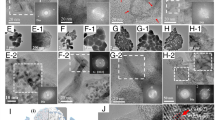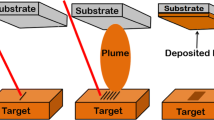Abstract
We grow hydrogenated amorphous silicon (a-Si:H) by Hot-Wire Chemical Vapor Deposition (HWCVD). Our early work with this technique has shown that we can grow a-Si:H that is different from typical a-Si:H materials. Specifically, we demonstrated the ability to grow a-Si:H of exceptional quality with very low hydrogen (H) contents (0.01 to 4 at. %). The deposition chambers in which this early work was done have two limitations: they hold only small-area substrates and they are incompatible with a load-lock. In our efforts to scale up to larger area chambers—that have load-lock compatibility—we encountered difficulty in growing high-quality films that also have a low H content. Substrate temperature has a direct effect on the H content of HWCVD grown a-Si:H. We found that making dramatic changes to the other deposition process parameters—at fixed substrate temperature and filament-to-substrate spacing—did not have much effect on the H content of the resulting films in our new chambers. However, these changes did have profound effects on film quality. We can grow high-quality a-Si:H in the new larger area chambers at 4 at. % H. For example, the lowest known stabilized defect density of a-Si:H is approximately 2 × 1016 cm−3, which we have grown in our new chamber at 18 Å/s. Making changes to our original chamber—making it more like our new reactor—did not increase the hydrogen content at a fixed substrate temperature and filament-to-substrate spacing. We continued to grow high quality films with low H content in spite of these changes. An interesting, and very useful, result of these experiments is that the orientation of the filament with respect to silane flow direction had no influence on film quality or the H content of the films. The condition of the filament is much more important to growing quality films than the geometry of the chamber due to tungsten-silicide formation on the filament.
Similar content being viewed by others
References
A.H. Mahan and M. Vanecek, Amer. Inst. of Phy. Conf. Proc. 234, 195 (1991).
B.P. Nelson, Q. Wang, E. Iwaniczko, A.H. Mahan and R.S. Crandall, Mater. Res. Soc. Proc. 507, San Francisco, CA, 1998 pp 927–932.
Q. Wang, B.P. Nelson, E. Iwaniczko, A.H. Mahan, R.S. Crandall and J. Benner, 2nd WCPEC, Vienna, Austria, 1998.
R.S. Crandall, A.H. Mahan, B.P. Nelson, M. Vanecek, I. Balberg, AIP Conf. Proc. 268, Photovoltaic Advanced Research & Development Project, Denver, CO 1992, pp. 81–87.
E.C. Molenbroek, A.H. Mahan, A. Gallagher, Jour. of Appl. Phys. 82 (4), 1909, 15 August 1997.
Author information
Authors and Affiliations
Rights and permissions
About this article
Cite this article
Nelson, B.P., Crandall, R.S., Iwaniczko, E. et al. Low Hydrogen Content, High Quality Hydrogenated Amorphous Silicon Grown by Hot-Wire CVD. MRS Online Proceedings Library 557, 97–102 (1999). https://doi.org/10.1557/PROC-557-97
Published:
Issue Date:
DOI: https://doi.org/10.1557/PROC-557-97




